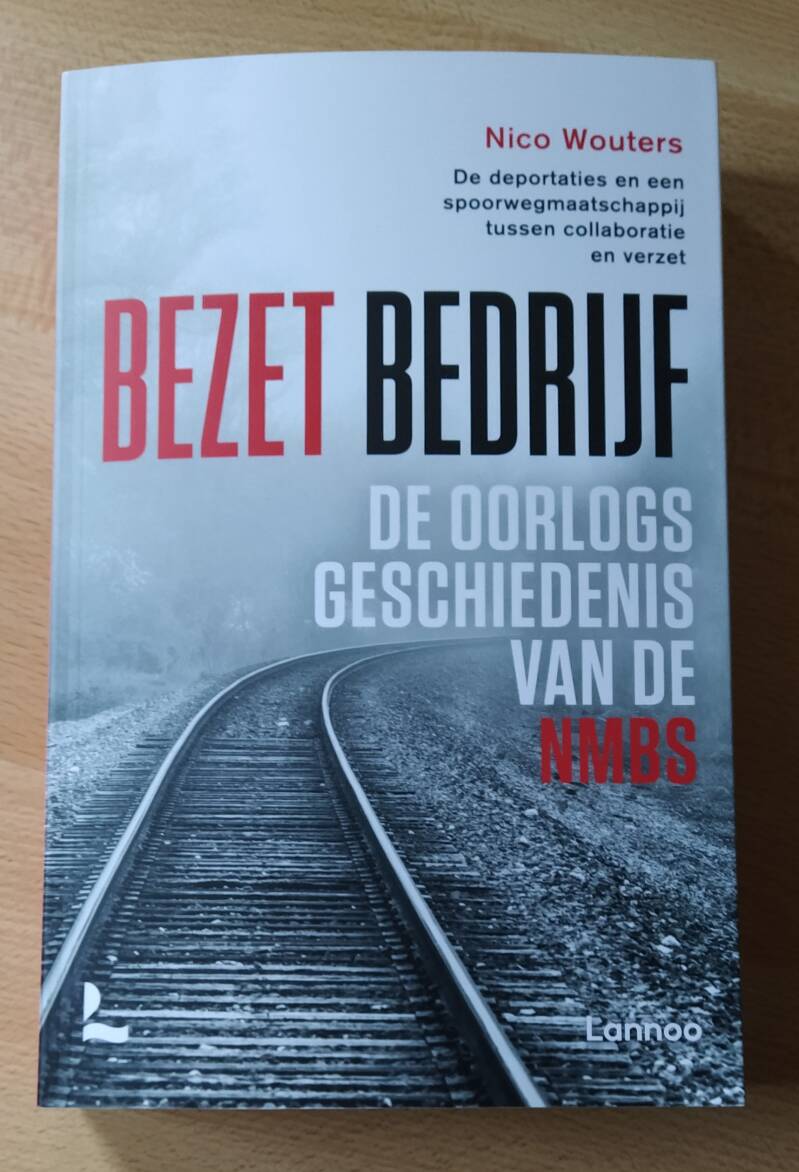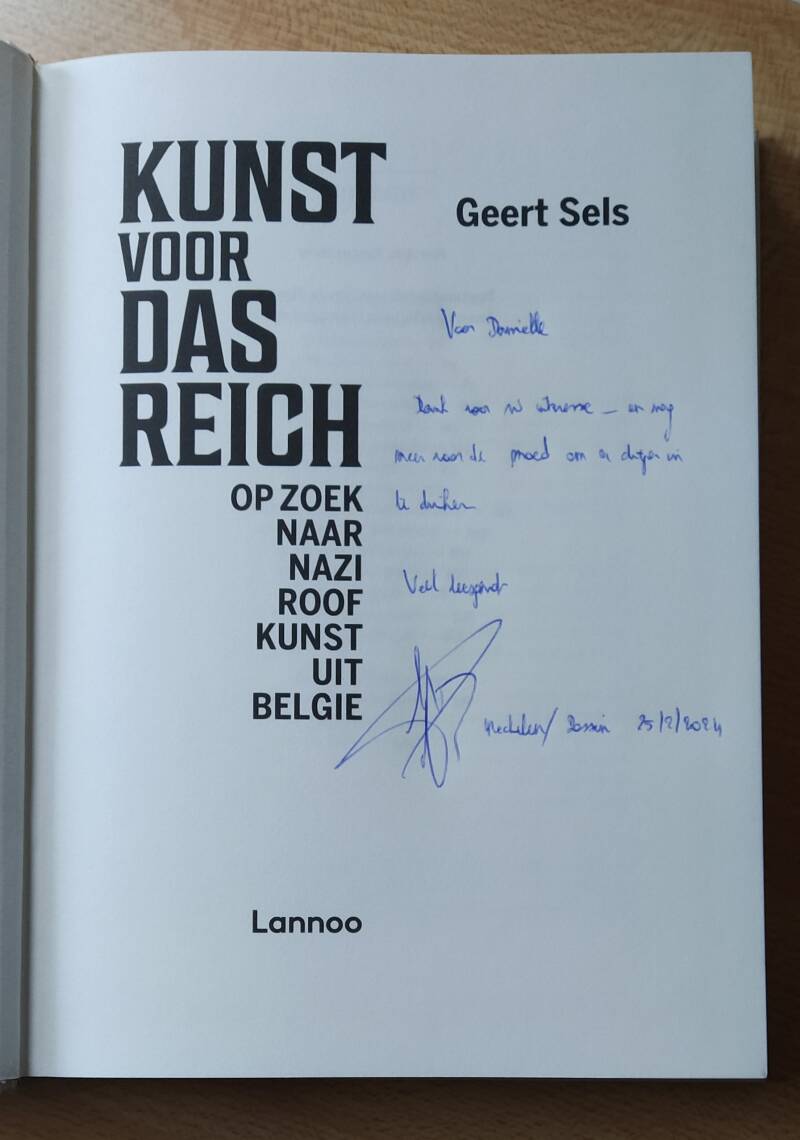Kazerne Dossin, Belgium - Book launch 25 February 2024.
Bezet bedrijf - De oorlogsgeschiedenis van de NMBS - Nico Wouters
Hét referentiewerk over de NMBS, en haar rol in de deportaties, het verzet en de collaboratie, tijdens de Tweede Wereldoorlog in bezet België
De treinen blijven rijden, ook tijdens de Duitse bezetting van België tijdens WO II. Hoe kan het ook anders? De NMBS is op dat moment het grootste bedrijf én de grootste openbare dienstverlener van België. Het mastodontbedrijf staat in voor de bevoorrading van een groot deel van de grondstoffen, materialen en voedsel, en heeft zo het lot van de Belgische bevolking en industrie in zijn handen.
Samenwerking met de bezetter wordt zo wel onvermijdelijk. En daar loopt het al snel grondig mis. De Belgische spoorwegen helpen tussen 1941 en 1944 mee aan de deportatie van 189.542 Belgische dwangarbeiders, 25.490 Joden, 16.081 politieke gevangenen en 353 Roma naar het oosten. Nico Wouters - oorlogshistoricus en directeur van het CegeSoma/Rijksarchief - analyseert de samenwerkingspolitiek van het Belgische spoorbedrijf en gaat daarbij geen enkele vraag uit de weg. Wie nam de beslissingen? Voerde de NMBS militaire opdrachten uit voor de Duitsers? Werd het bedrijf betaald voor de deportatietreinen? Waren er marges voor onderhandeling en waarvoor werden die (niet) gebruikt? Welke rol speelde het sterk aanwezige verzet?
Ondanks de toenemende weerstand blijven de treinen nagenoeg tot de laatste oorlogsdag in dienst van de Duitsers rijden. Hoe kunnen we dat met de kennis en de blik van vandaag verklaren? Dit verhaal kent geen simplistische schema's van zwart of wit. Dat maakt het des te interessanter, want precies in de grijze zones liggen de moeilijkste keuzes en daarom de meest relevante inzichten.
Occupied company - The war history of the NMBS
The reference work on the NMBS, and its role in the deportations, resistance and collaboration, during the Second World War in occupied Belgium
The trains continued to run, even during the German occupation of Belgium during WWII. How could it be different? At that time, NMBS was the largest company and the largest public service provider in Belgium. The mastodon company is responsible for the supply of a large part of the raw materials and food, and thus has the fate of the Belgian population and industry in its hands.
Cooperation with the occupier thus becomes inevitable. And that's where things quickly go terribly wrong. Between 1941 and 1944, the Belgian railways helped deport 189,542 Belgian forced laborers, 25,490 Jews, 16,081 political prisoners and 353 Roma to the east. Nico Wouters - war historian and director of the CegeSoma/State Archives - analyzes the cooperation policy of the Belgian railway company and does not avoid any questions. Who made the decisions? Did NMBS carry out military assignments for the Germans? Was the company paid for the deportation trains? Were there margins for negotiation and what were they (not) used for? What role did the strong resistance play?
Despite the increasing resistance, the trains continued to run in German service almost until the last day of the war. How can we explain this with today's knowledge and perspective? This story has no simplistic schemes of black or white. That makes it all the more interesting, because it is precisely in the gray zones that the most difficult choices and therefore the most relevant insights lie.
Kunst voor das Reich - Op zoek naar naziroofkunst uit België - Geert Sels
Hoe de nazi's massaal kunst uit België weghaalden
Tijdens de Tweede Wereldoorlog vond er een immense kunstroof plaats. Vanuit de bezette gebieden versleepten de nazi's kunst naar Duitsland om ambitieuze collecties op te zetten. Voor het eerst wordt dat verhaal voor België verteld. Hoe konden schilderijen van Memling, Van der Weyden, Brueghel, Jordaens en Cranach zomaar het land verlaten? De nazi's haalden woningen leeg, roofden kunst, dwongen eigenaars te verkopen en spendeerden miljoenen rijksmarken op de kunstmarkt.
Na 8 jaar onderzoek legt Geert Sels de puzzelstukken bij elkaar die hij aantrof in archieven in Parijs, Den Haag, Koblenz en de grootste Belgische steden. Met doorgedreven speurwerk brengt hij de trajecten in kaart waarlangs de kunst werd weggehaald. Hij stelt vast dat verzamelaars, handelaars en veilinghuizen zonder veel terughoudendheid meegingen in de kunstverwerving van de nazi's.
Na de oorlog vonden schilderijen uit België hun weg naar het Louvre, Tate Britain, het Getty Museum of de Yale Art Gallery. Nederland, Frankrijk, Duitsland en zelfs Rusland blijken nog altijd kunst te hebben die naar België had moeten terugkeren. Dat maakt het Belgische verhaal tot een internationaal verhaal. Andere werken kwamen wel terug en hangen nu in Belgische musea, maar zonder dat de rechtmatige eigenaars werden opgespoord.
Waarom is dat niet gebeurd? In tegenstelling tot andere landen is België pijnlijk passief gebleven inzake naziroofkunst. Kunst voor das Reich brengt een ongemakkelijke waarheid en is een stresstest voor het overheidsbeleid. Vergeten dossiers komen bloot te liggen en de duistere kant van schilderijen in onze musea wordt belicht.
Art for the Reich - Looking for Nazi looted art from Belgium - Geert Sels
How the Nazis removed art from Belgium en masse.
An immense art theft took place during the Second World War. The Nazis transported art from the occupied territories to Germany to set up ambitious collections. For the first time, that story is being told for Belgium. How could paintings by Memling, Van der Weyden, Brueghel, Jordaens and Cranach just leave the country? The Nazis emptied homes, stole art, forced owners to sell and spent millions of Reichsmarks on the art market.
After 8 years of research, Geert Sels puts together the pieces of the puzzle that he found in archives in Paris, The Hague, Koblenz and the largest Belgian cities. With extensive detective work, he maps the routes along which the art was removed. He notes that collectors, dealers and auction houses went along with the Nazis' art acquisition without much reservation.
After the war, paintings from Belgium found their way to the Louvre, Tate Britain, the Getty Museum or the Yale Art Gallery. The Netherlands, France, Germany and even Russia still appear to have art that should have been returned to Belgium. That makes the Belgian story an international story. Other works were returned and are now in Belgian museums, but without the rightful owners being traced.
Why didn't that happen? Unlike other countries, Belgium has remained painfully passive when it comes to Nazi looted art. Art for the Reich conveys an uncomfortable truth and is a stress test for government policy. Forgotten files are exposed and the dark side of paintings in our museums is highlighted.







